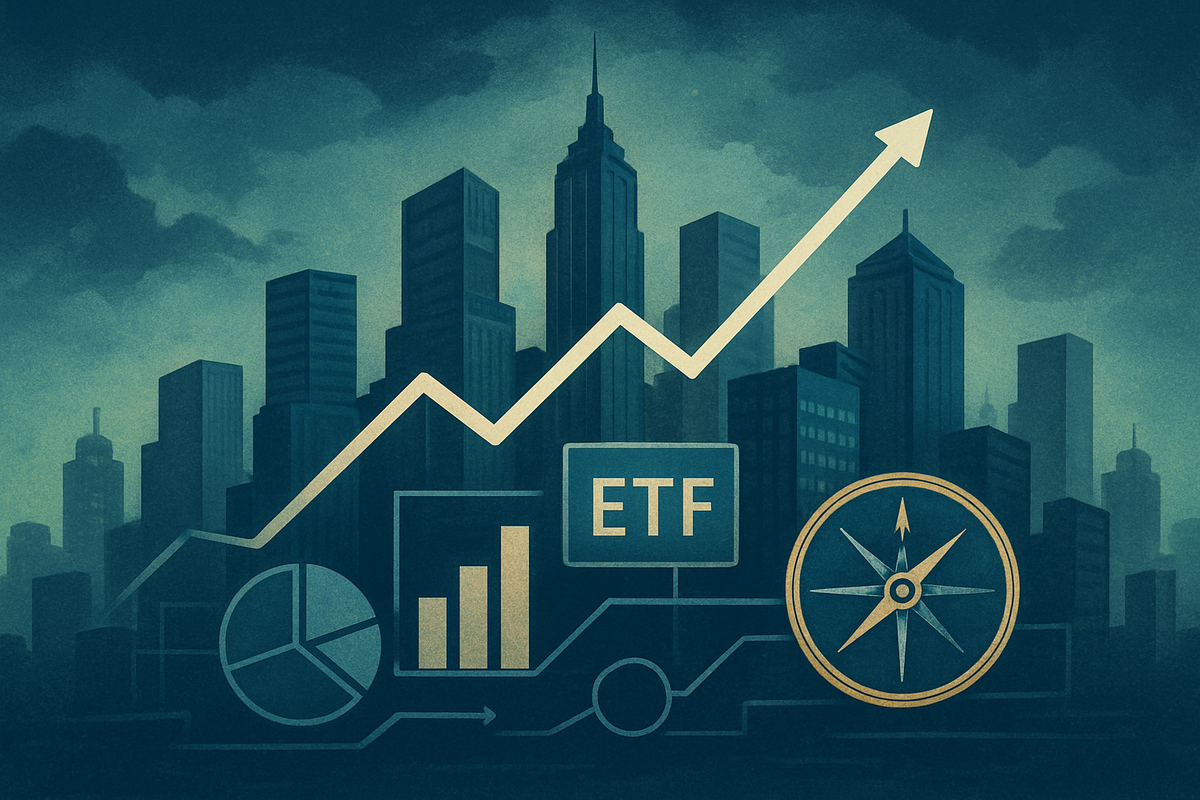
The global stock market finds itself at a pivotal juncture in late 2025, with valuations reaching levels that many seasoned analysts are labeling as "expensive." Driven by robust corporate earnings, an insatiable appetite for artificial intelligence (AI) innovation, and a prolonged period of accommodative monetary policy, key market indicators like the S&P 500's P/E and CAPE ratios are significantly elevated compared to historical averages. This high-valuation environment presents both opportunities and considerable risks for investors, prompting a critical re-evaluation of traditional investment strategies. As the market continues to defy gravity, the focus shifts to defensive and adaptive approaches, with Exchange Traded Funds (ETFs) emerging as a versatile tool to manage risk, diversify portfolios, and pinpoint growth in a landscape where premiums are the norm.
Understanding the Current Valuation Landscape
As of late October 2025, the U.S. stock market exhibits a clear pattern of stretched valuations, triggering caution among investors and analysts alike. The S&P 500's (SPX) trailing twelve-month Price-to-Earnings (P/E) ratio has climbed to approximately 30.9, significantly above its historical median of 17.98. Similarly, the Cyclically Adjusted Price-Earnings (CAPE) ratio, or Shiller P/E, stands at a striking 39.51 to 40.35. These figures are alarmingly close to the peak observed just before the dot-com bubble burst in 1999-2000, which reached 44.2, and far surpass the long-term historical average of around 16.03.
The timeline leading to these elevated levels has been characterized by an accelerated ascent in valuations, particularly throughout 2024 and 2025. A significant driver has been the unprecedented boom in artificial intelligence (AI) technologies, which has fueled a speculative frenzy in the technology sector. AI stocks now comprise an estimated 44% of the S&P 500's market capitalization, a substantial increase from 26% in late 2022. This concentration in a few high-growth sectors, reminiscent of past bubbles, has propelled overall market indices to new records. Key players in this surge include major technology giants like Nvidia (NVDA), Microsoft (MSFT), and Alphabet (GOOGL), whose robust performance and optimistic future projections have heavily influenced market sentiment.
Beyond the tech sector, broader market optimism has been underpinned by expectations of continued strong corporate profit growth and anticipated Federal Reserve rate cuts aimed at supporting a slowing job market. This confluence of factors has encouraged investors to pay a premium far beyond historical norms for corporate earnings and underlying economic output. The "Buffett Indicator," which measures total market capitalization to GDP, has also reached an unprecedented 219% to 224.7% in October 2025, vastly exceeding its historical average of 80% to 100% and signaling extreme overvaluation. Initial market reactions have been a mix of exhilaration over new highs and a growing undercurrent of concern regarding the sustainability of these valuations, with some analysts pointing to heavy insider selling in tech stocks as a potential red flag.
Corporate Fortunes in a Premium Market
In an "expensive" stock market, the dynamics of corporate performance and investor perception create distinct winners and losers. Companies that continue to demonstrate exceptional growth, particularly those at the forefront of transformative technologies like Artificial Intelligence, tend to be rewarded with even higher valuations. For instance, companies such as Nvidia (NVDA), a leader in AI chips, and Microsoft (MSFT), with its extensive AI integration across its product suite, have seen their stock prices surge, reflecting investor confidence in their future earnings potential despite already high P/E ratios. These companies often possess strong competitive moats, innovative pipelines, and the ability to consistently exceed earnings expectations, justifying their premium pricing to a degree. However, their high valuations also make them particularly vulnerable to any slowdown in growth or unexpected negative news.
Conversely, companies with more modest growth prospects, those in mature industries, or those struggling with profitability, often find themselves under increased scrutiny in a high-valuation environment. Investors become less forgiving of missed earnings or stagnant revenue growth when the broader market is priced for perfection. Value stocks, which typically trade at lower multiples, may continue to lag if the market's focus remains on growth at any price. Furthermore, highly leveraged companies or those sensitive to interest rate fluctuations could face headwinds, as higher market valuations often precede periods of tighter monetary policy or increased volatility. The risk for these companies is not just underperformance but potential capital erosion if a market correction occurs, as their valuations offer less of a buffer.
The current environment also highlights a growing divergence between companies with strong balance sheets and those with weaker financial footing. In an expensive market, capital can become more selective, flowing primarily to established leaders or disruptors. Smaller, less proven companies, even those with innovative ideas, might struggle to attract investment if they do not show immediate and substantial returns, as investors prioritize stability and proven profitability in a potentially overheated market. This dynamic could lead to a widening gap between market leaders and laggards, further exacerbating the "winner-take-all" mentality observed in specific sectors like technology.
ETFs as a Strategic Compass in High Valuations
Navigating an expensive stock market requires a strategic approach to risk management, diversification, and opportunity identification. Exchange Traded Funds (ETFs) offer a versatile toolkit for investors to address these challenges. Unlike individual stocks, ETFs inherently provide diversification across multiple assets, sectors, or even entire market segments, thereby mitigating single-stock risk—a crucial benefit when individual company valuations are stretched. For instance, instead of picking an expensive AI stock, an investor might opt for a broad technology ETF like the Technology Select Sector SPDR Fund (XLK) or a specialized AI ETF, gaining exposure to the sector's growth while spreading risk across numerous companies.
Several ETF strategies become particularly pertinent in a high-valuation environment. Value ETFs, such as the iShares S&P 500 Value ETF (IVE), focus on companies trading at lower multiples relative to their earnings or book value. While these may have underperformed during the recent growth surge, they offer a potential hedge against a broader market correction, as their lower valuations provide a greater margin of safety. Similarly, Dividend ETFs, like the Vanguard Dividend Appreciation ETF (VIG), target companies with a history of consistent dividend payments, often indicative of financial stability and mature business models, providing income and potentially more stable returns during volatile periods.
Furthermore, Low-Volatility ETFs, such as the iShares Edge MSCI Min Vol USA ETF (USMV), can be invaluable. These funds invest in stocks that have historically exhibited lower price fluctuations than the broader market, offering a more defensive posture in an expensive and potentially volatile environment. For investors seeking to actively hedge against a downturn, Inverse ETFs (e.g., ProShares Short S&P500, SH) or Leveraged Inverse ETFs (e.g., ProShares UltraPro Short S&P500, SPXU) can be considered, though these carry significantly higher risk and are generally suitable only for sophisticated investors with a short-term outlook. Finally, Sector-Specific ETFs allow for targeted exposure to areas still showing strong fundamentals despite overall market valuations, or those that might benefit from specific economic trends, enabling investors to be selective without the deep research required for individual stock picking.
Adapting to the Shifting Sands: What Comes Next
The trajectory of an expensive stock market is inherently uncertain, presenting a range of short-term and long-term possibilities. In the short term, the market could continue its upward climb, driven by sustained corporate earnings growth, further AI innovation, or continued liquidity. However, the elevated valuations also increase the probability of a significant correction or increased volatility. A sudden shift in economic data, an unexpected geopolitical event, or a change in central bank policy could serve as a catalyst for a downturn. Investors should brace for potentially sharper pullbacks than those experienced in more moderately valued markets.
Long-term possibilities include a prolonged period of lower-than-average returns, as suggested by historical precedents linked to high CAPE ratios. Alternatively, if technological advancements, particularly in AI, continue to drive unprecedented productivity gains, current valuations might eventually be justified by future earnings growth, leading to a "new normal" for market multiples. This scenario, however, carries the risk of a "soft landing" or even a "no landing" where the economy avoids recession despite higher interest rates.
Strategic pivots or adaptations will be crucial for investors. This includes a greater emphasis on active portfolio management, potentially shifting allocations towards defensive sectors, high-quality dividend payers, or international markets that may offer more attractive valuations. For ETF users, this might mean rebalancing towards value-oriented, low-volatility, or diversified global equity ETFs. Market opportunities could emerge in specific niches that are undervalued or poised for structural growth independent of broad market sentiment. Conversely, challenges will include navigating increased market sensitivity to news, the potential for sector rotations, and the psychological difficulty of staying disciplined during periods of both exuberant highs and sharp declines. Potential scenarios range from a gradual unwinding of valuations to a more abrupt market correction, with outcomes heavily dependent on economic fundamentals, corporate earnings, and investor sentiment.
A Prudent Path Forward in a Premium Market
In summary, the current market environment, characterized by significantly elevated P/E and CAPE ratios, an unprecedented Buffett Indicator, and a concentrated surge in AI-driven technology stocks, clearly signals an "expensive" stock market as of late 2025. This backdrop necessitates a thoughtful and disciplined investment approach, moving beyond the passive strategies that thrived during periods of lower valuations. The key takeaway for investors is the heightened importance of risk management, diversification, and selective exposure to growth.
Moving forward, the market is likely to remain sensitive to economic data, corporate earnings reports, and any shifts in Federal Reserve policy. The sustainability of current valuations hinges on whether robust corporate profit growth can continue to materialize and if the AI revolution can deliver on its immense promise without creating an unsustainable bubble. Investors should closely monitor indicators such as corporate profit margins, consumer spending trends, inflation data, and any signs of speculative excess in specific sectors.
ETFs emerge as a powerful tool for navigating this complex landscape. By utilizing value-oriented, dividend-focused, low-volatility, or strategically diversified sector ETFs, investors can tailor their portfolios to manage risk, capture specific growth themes, and potentially cushion against downturns. However, it is crucial to understand the underlying holdings and objectives of each ETF. The coming months will test the resilience of the market and the conviction of investors, making prudent, well-researched decisions more critical than ever.
This content is intended for informational purposes only and is not financial advice






